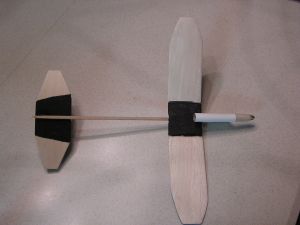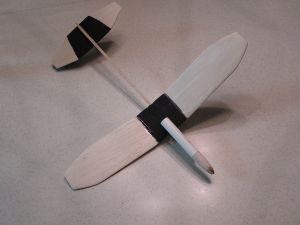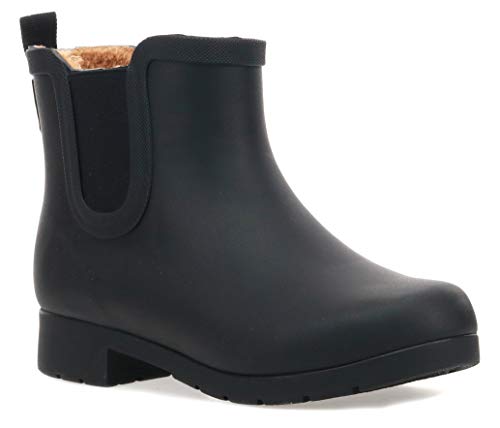Qualified Competition Rockets Easy Slide III
Qualified Competition Rockets - Easy Slide III
Contributed by Ray King
| Construction Rating: | starstarstarstar_borderstar_border |
| Flight Rating: | starstarstarstarstar_border |
| Overall Rating: | starstarstarstar_borderstar_border |
| Manufacturer: | Qualified Competition Rockets  |

Brief:
The Easy Slide III is C motor sliding wing rocket glider sold by QCR (Qualified Competition Rockets). It uses an 18mm
motor mount and rubber band loaded wing that slides forward after the ejection charge burns the thread holding the wing
in place.
Construction:
This kit is supplied with:
- 1 Nose Cone
- 1 Body Tube
- 3/16” Thick Balsa Wing
- 3/32” Thick Balsa Horizontal Stabilizer
- 3/32” Thick Balsa Rudder
- 1/16” Thick Plywood Wing Support
- 1/16” Thick Plywood Stab Incidence Shim
- 1 0.026” Wire Hook (J-shape)
- 1 0.026” Wire Hook (squared U-shape)
- 2 Wire Launch Lugs Hooks (Elected not to use)
- 1 0.026” Wire Hook (small U-shape)
- 1 Engine Hook (Elected not to use)
- 2 Small plastic "sliding box" pieces

QCR kits are competition kits designed for experienced builders. The instructions outline the only basics. As a beginner rocket glider builder, I struggled through this build because of the lack of step-by-step the instructions.
I started by cutting out the wings from the marked balsa sheets provided. Rather than having templates to follow, the balsa sheets were marked with cutting lines. Next, I shaped all the balsa components: the wings, stabilizer, rubber, and boom support. I spent the most time shaping the airfoil on the main wing. After I was satisfied with the airfoil I cut the wing and epoxied in place with 5 minute epoxy to create the dihedral. Next, I epoxied the plastic boxes to the plywood wing support. This was a little tricky--the boxes need to be perfectly aligned to ensure the boom can slide smoothly through both without binding. I punched small holes in the plywood prior to gluing to the wing to ensure the best attachment possible.
I attached 3 of the 5 hooks provided. I installed the large “U” shaped hook for the main wing, and the small “U” shaped hook to the one end of the boom. I glued the rudder to the horizontal stabilizer ensuring the rudder was straight. Next, I glued this assembly to very end of the boom near the small “U” shaped wire. A small plywood shim was glued under the front of the horizontal stabilizer to establish the correct stab incidence.
I assembled the motor tube, nose cone, and boom support but elected to not use the engine hook or the U-shaped launch rod wire forms. I planned to use this in competition and launch from a piston so neither of these were required.
Next, I slid the wing in place and then attached the motor-nose cone assembly to the boom. The J-shaped hook was installed on the very front of the boom.
 I prepped the glider for flight by installing a used motor and rubber band to hold the wing
forward. This was the first rocket glider I had ever assembled so I didn't know what to expect for the first hand
launch. I was amazed it flew very well. I did a little more trimming by adjusting the stop location of the main wing
and I was ready for the first flight.
I prepped the glider for flight by installing a used motor and rubber band to hold the wing
forward. This was the first rocket glider I had ever assembled so I didn't know what to expect for the first hand
launch. I was amazed it flew very well. I did a little more trimming by adjusting the stop location of the main wing
and I was ready for the first flight.
PROs: The components were of good quality and the glider needed very little trimming to fly very nicely.
CONs: The instructions were not meant for a beginner. QCR should consider updating their documentation.
Finishing:
Since this is a competition model, all I did was use magic marker to create a visible surface in the air as well as
on the gone.
Construction Rating: 3 out of 5
Flight and Recovery:
Flight prep reminded me of a helicopter model. To ensure the thread burned, I taped over one of the vent holes
completely and partially covered the second with Mylar tape.
The first launch was on a B6-4 off of a piston. The launch was nice and straight, turning a bit into the wind, but overall all very nice boost. Transition to glide was after apogee, a little late. The glider flew pretty well, but it did need some additional trimming. The flight was 17 seconds which I was please with considering how windy it was.
The second launch was on a C6-3 again off of piston. Just after launch the rocket flew almost horizontal and the wing broke under boost causing the rocket to spin to the ground. I realized after rebuilding the instructions highlight the need to reinforce the main wing with packaging tape. I have incorporated this into the rebuilt model. The rocket has great potential and I am looking forward to the next launch
Flight Rating: 4 out of 5
Summary:
I think this is very good rocket glider. I can't wait to fly it some more and refine my trimming and flying ability.
Although I struggled with the instructions, the sketchy detail has built my confidence and I am looking forward to
building more models of this type.
Overall Rating: 3 out of 5
Sponsored Ads
 |
 |











